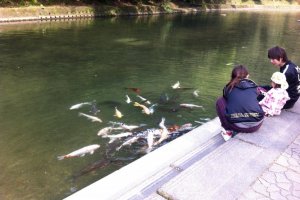Ōsumi Peninsula in southeastern Kyūshū’s Kagoshima Prefecture has historically been one of the farthest outposts of the mainland Japanese empire. This sense of remoteness is still mostly true today. Without so much as a train station to connect it to the rest of the country, Ōsumi remains one of the most rural and least visited places in all of mainland Japan. However, there is history here in this far-flung part of the country that will certainly pique the interests of history buffs or off-the-beaten-path travelers.
For the imperial family, Ōsumi’s beauty and seclusion on Kyūshū’s southernmost peninsula provided them the perfect location for a southern palace. Though the palace has long since vanished, the mythological history of the imperial family in Kyūshū remains. It is said in the Nihonshoki, one of Japan’s oldest books of recorded history, that the parents of Japan’s mythical first emperor, Emperor Jimmu, died and were entombed in the hills near what is today Aira Town. In 1874, the Japanese government determined Aira Sanyro to be the official imperial burial grounds of the first Japanese Emperor’s ancestors, dating back to 660B.C.E. Today, Aira Sanryo’s surrounding forest, riverside, and park are a popular spot for picnickers, day-trippers and payers of homage during the spring, fall and New Year’s holiday.
In March and April, the park draws picnickers for hanami (cherry blossom viewing) with its array of pink and white blooms heralding the return of spring. Do hanami right by sharing a drink with the locals under the splendor of the trees. Fall is especially spectacular at the Sanryo, when the forest bursts into color as the maples, contrasted by the rest of the coniferous cedar forest, turn their signature shade of crimson. New Year’s festivities are held at the Sanryo every January. Despite the cold, worshippers come to pay their respects to the first emperor of Japan on the occasion of the New Year. Whether the origin stories are myth or fact doesn’t seem to affect the reverence given to the Emperor. In Japan, the relationship between the land, the people, and their sovereign is an unbreakable one, a tradition that began long ago with the ascension of Emperor Jimmu.
To view Aira Sanryo, follow the walking path over the stone bridge and through the forest. The path will widen and open up toward the end of the river valley. Tucked away in a cave framed by a stone torii is Aira Sanryo. The tomb itself is sacred, and therefore inaccessible to anyone but members of the imperial family and its guardians. The viewing point, however, located across the river from the tomb, affords you a decent vantage point of the entrance. Back near the picnicking area, the river is stocked with large colorful koi, eager to eat from the palms of curious onlookers.
Aira Sanryo is located 35 minutes south of Kanoya, just outside of Aira Town on Route 544. Nearby, Ōsumi Regional Park offers camping and other outdoor activities. During the summer, you can pick your own strawberries and grapes from the tourist farm. Share your bounty with the locals and you might find yourself an honorary member of the party. Who’d say “no” to good company, free beer and a bento?

































